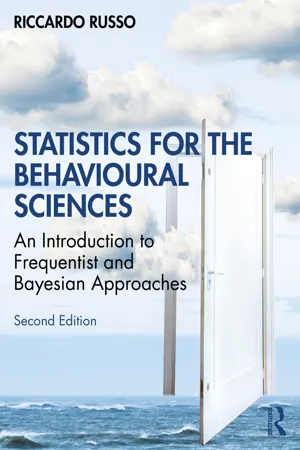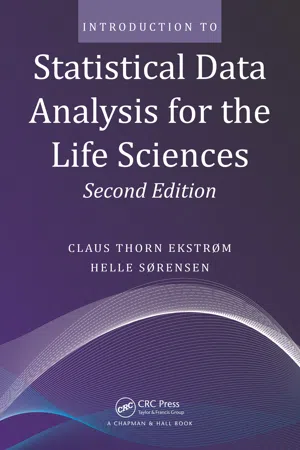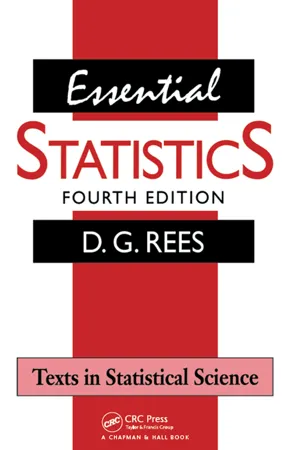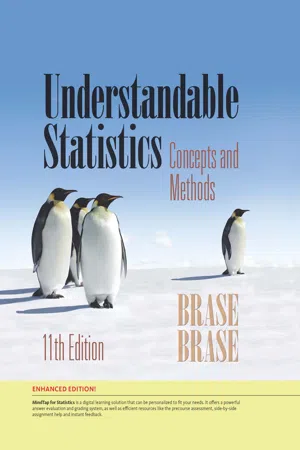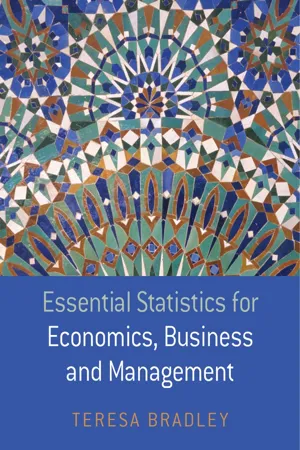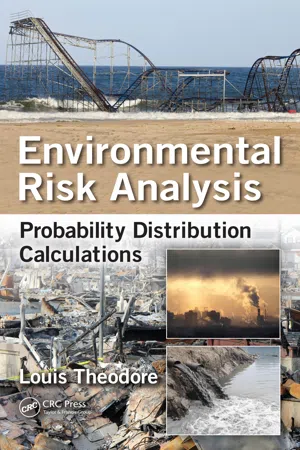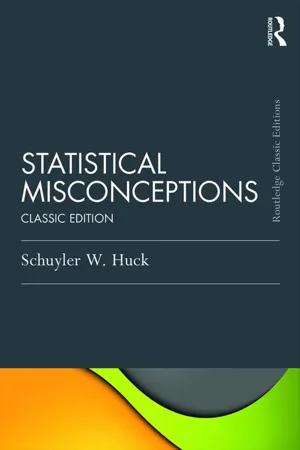Mathematics
Binomial Distribution
The binomial distribution is a probability distribution that describes the number of successes in a fixed number of independent trials, each with the same probability of success. It is characterized by two parameters: the number of trials and the probability of success on each trial. The distribution is widely used in statistics and probability theory to model various real-world phenomena.
Written by Perlego with AI-assistance
Related key terms
1 of 5
11 Key excerpts on "Binomial Distribution"
- eBook - ePub
Probability
An Introduction
- Samuel Goldberg(Author)
- 2013(Publication Date)
- Dover Publications(Publisher)
Chapter 5 Binomial Distribution AND SOME APPLICATIONS1. Bernoulli trials and the Binomial DistributionCertain kinds of experiments and associated random variables occur time and again in the theory of probability and in its applications. They are therefore made the object of special study in which their properties are explored, values of frequently needed probabilities are tabulated, and so on. In this section, we describe a number of such experiments and random variables, paying special attention to the so-called binomial probability function. In the final sections of this chapter, we discuss two important problems of statistics in which this function plays a central role.As we have seen in numerous examples throughout this book, many problems involve experiments made up of a number, say n, of individual trials. Each trial is itself really an arbitrary experiment, and is therefore defined in the mathematical theory by some sample space and assignment of probabilities to its simple events. The trials can be independent or dependent, and the simple events of the sample space for the n-trial experiment are assigned probabilities accordingly.Although each trial may have many possible outcomes, we are often interested only in whether a certain result occurs or not. For example, a machine turns out parts which are classified defective or good; a card is selected from a standard deck and it is an ace or not an ace; two dice are rolled and the sum of the numbers showing is seven or is different from seven; a student selected from the senior class has a part-time job or has not; etc.In order to have a convenient standard terminology for discussing all such trials, we shall call one of the two possible results of each trial a success and the other a failure - Rajan Chattamvelli, Ramalingam Shanmugam(Authors)
- 2022(Publication Date)
- Springer(Publisher)
17 C H A P T E R 2 Binomial Distribution After finishing the chapter, readers will be able to : : : • Understand Bernoulli and Binomial Distributions. • Explain properties of Binomial Distribution. • Describe special Binomial Distributions. • Comprehend applications of Binomial Distribution in engineering. • Explore Binomial Distribution in applied sciences. 2.1 INTRODUCTION Bernoulli distribution is one of the simplest discrete distributions. A good understanding of this distribution is essential to grasp the binomial, geometric, and negative Binomial Distributions discussed in subsequent chapters. This distribution is based upon the Bernoulli trial defined below. Either a dichotomous categorical variable, also called binary variable (like gender) or a quantitative variable (like income), may underlie the experimentation. Assigning probabilities to the outcomes is much easier in the case of categorical variables. 2.1.1 BERNOULLI TRIALS A Bernoulli trial is a random experiment that results in exactly two possible outcomes each time it is repeated, which are by convention denoted by “success” .S/ and “failure” .F /, in which the probability of success is the same every time it is conducted under identical conditions. Such an experiment is known as a Bernoulli trial. Here “trial” is synonymous with “experiment” or “experimentation.” It may also result from a physical test of a quality, detection of “noise only” or “noise plus signal” in signal processing problems, measurement of an attribute (like body temperature), presence of a symptom or a microbe (like COVID-19), or from accumulated knowledge from past data (like relative frequency of occurrence of an event like defect). These are discussed in detail in numerous examples.- eBook - ePub
Statistics for the Behavioural Sciences
An Introduction to Frequentist and Bayesian Approaches
- Riccardo Russo(Author)
- 2020(Publication Date)
- Routledge(Publisher)
5 Probability distributions and the Binomial Distribution 5.1 Introduction The main aim of this chapter is to provide a description of the characteristics of the Binomial Distribution and its use in testing hypotheses. This is a particularly useful distribution. Consider a situation where a series of independent events occurs (e.g., a fair coin is tossed four times), and the outcome of each event can be either a success (e.g., “Head”) or a failure (e.g., “Tail”). We can then count the number of successes that can be obtained when a coin is tossed four times (i.e., 0, 1, 2, 3, and 4), and calculate the probability of obtaining each one of these five outcomes. The Binomial Distribution describes the probability of each of the outcomes of the above discrete random variable, i.e., “number of successes obtained when a coin is tossed four times”. This brief description of the Binomial Distribution may seem quite obscure at this stage. The introduction of a series of concepts will provide enough background for a more comprehensive presentation of this important probability distribution. We will also describe how the Binomial Distribution can be used in testing a hypothesis. For example, if you want to test whether a coin is biased you could simply toss the coin 20 times, record the number of “Heads” (e.g., 16), and compare this value with the Binomial Distribution of the discrete random variable “number of Heads obtained when a fair coin is tossed 20 times”. If the observed value is somehow at odds with the values given by the Binomial Distribution of the above variable, then there is good evidence that the coin is biased - eBook - ePub
Statistics for the Behavioural Sciences
An Introduction
- Riccardo Russo(Author)
- 2004(Publication Date)
- Psychology Press(Publisher)
Chapter 4 Probability distributions and the Binomial DistributionIntroduction
The main aim of this chapter is to provide a description of the characteristics of the Binomial Distribution and its use in testing hypotheses. This is a particularly useful distribution. Consider a situation where a series of independent events occurs (e.g., a fair coin is tossed four times), and the outcome of each event can be either a success (e.g., “Head”) or a failure (e.g., “Tail”). We can then count the number of successes that are obtained when a coin is tossed four times (i.e., 0, 1, 2, 3, 4), and calculate the probability of obtaining each one of these five outcomes. The Binomial Distribution describes the probability of each of the outcomes of the above discrete random variable, i.e., “number of successes obtained when a coin is tossed four times”. This brief description of the Binomial Distribution may seem quite obscure at this stage. The introduction of a series of concepts will provide enough background for a more comprehensive presentation of this important probability distribution. We will also describe how the Binomial Distribution can be used in testing a hypothesis. For example, if you want to test whether a coin is biased you could simply toss the coin 20 times, record the number of “Heads” (e.g., 16), and compare this value with the Binomial Distribution of the discrete random variable “number of Heads obtained when a fair coin is tossed 20 times”. If the observed value is somehow at odds with the values given by the Binomial Distribution of the above variable, then there is good evidence that the coin is biased. In this chapter we will describe the Binomial Distribution, and how to apply it in the process of hypothesis testing applied both to relatively abstract situations, like the above example about the coin, and to research in the behavioural sciences.The first thing to define is the term discrete random variable - Claus Thorn Ekstrom, Helle Sørensen(Authors)
- 2014(Publication Date)
- Chapman and Hall/CRC(Publisher)
Chapter 11 The Binomial Distribution Binary variables are variables with only two possible outcomes (“success” and “failure”). The statistical models from the previous chapters are not meaningful for such response variables because the models used the normal or Gaussian distribution to describe the random variation; in particular, the response was assumed to be continuous. In the remaining chapters we will discuss statistical models for binary data and count data where the response is discrete. 11.1 The independent trials model First we will present the design behind the independent trials model or Bernoulli trials , which describes a sequence of trials or experiments. Data for the independent trials model for n trials should fulfill the following criteria: • There are two possible outcomes for each trial: “success” and “failure”. • Each trial has the same probability of success, p . • The outcome of one trial does not influence the outcome of any of the other trials (the independence property). The independent trials model is clearly different from the linear models we have looked at thus far. There are only two possible outcomes for the re-sponse, “success” and “failure”, and there is a single probability, p , of each trial being a success. This probability is an unknown parameter in the model. The outcome consists of all possible combinations of successes and fail-ures, and if we use the independence property we can easily calculate the corresponding probabilities using the multiplication rule (10.7). Example 11.1. Independent trials . Assume, for example, that we have n = 3 trials and that the probability of success is p . There are 2 3 = 8 possible ordered outcomes that we can observe: SSS SSF SFS FSS SFF FSF FFS FFF 307 308 Introduction to Statistical Data Analysis for the Life Sciences where S represents success and F is failure. The result FSF means that the first trial was a failure, the second a success, and the third a failure.- eBook - PDF
- D.G. Rees(Author)
- 2018(Publication Date)
- Chapman and Hall/CRC(Publisher)
Otherwise, there is a danger that each distribution may be seen by the student as a different ‘rabbit’ pulled out of a hat. It is left as an exercise for the reader to check that Minitab gives an answer of 0.0311 to compare with 0.0318 above. 6.16 Summary The binomial and the Poisson distributions are two of the most important discrete probability distributions. The Binomial Distribution gives the prob-abilities for the numbers of successes in a number of (Bernoulli) trials, if four conditions hold. Binomial probabilities may be obtained using For-mula (6.3) or, in certain cases, Table C.l or Minitab for Windows. The Poisson distribution gives the probabilities for the number of random events per unit time or space. Poisson probabilities may be calculated using Formula (6.5) or, in certain cases, Table C.2 or Minitab for Windows. lip < 0.1, it may be preferable to calculate binomial probabilities using the Poisson approximation to the binomial. Worksheet 6: The Bernoulli, Binomial, and Poisson Distributions 1. What is a Bernoulli trial? 2. What does the parameter p in a Bernoulli trial stand for? 3. The two outcomes of a Bernoulli trial are usually called success and failure. Which outcome shall I call success, and which failure? 82 ■ Essential Statistics 4. What is the general name for a variable which has a Binomial Distribution? 5. How can you tell a priori whether a discrete random variable has a Binomial Distribution? 6. Why can we think of a Bernoulli distribution as a special case of a Binomial Distribution? 7. For the distribution B(3, 0.5): (a) How many outcomes are there to each trial? (b) How many trials are there? (c) How many possible values can the variable take? (d) What is the mean and what is the standard deviation of this distribution? (e) Is this distribution symmetrical? Give a reason for your answer. Note: questions 8, 9, an d 10 are multiple choice. Choose one o f the three options in each case. - No longer available |Learn more
Understandable Statistics
Concepts and Methods, Enhanced
- Charles Henry Brase, Corrinne Pellillo Brase(Authors)
- 2016(Publication Date)
- Cengage Learning EMEA(Publisher)
Suppose you make n attempts to succeed at a certain project. How can you use the binomial probability distribution to compute the probability of r successes? (SECTION 5.2) How do you compute m and s for the Binomial Distribution? (SECTION 5.3) How is the Binomial Distribution related to other probability distributions, such as the geometric and Poisson? (SECTION 5.4) Andresr/iStockphoto.com Mitch Wojnarowicz/The Image Works Copyright 201 Cengage Learning. All Rights Reserved. May not be copied, scanned, or duplicated, in whole or in part. Due to electronic rights, some third party content may be suppressed from the eBook and/or eChapter(s). Editorial review has deemed that any suppressed content does not materially affect the overall learning experience. Cengage Learning reserves the right to remove additional content at any time if subsequent rights restrictions require it. 198 Chapter 5 THE BINOMIAL PROBABILITY DISTRIBUTION AND RELATED TOPICS Introduction to Random Variables and Probability Distributions FOCUS POINTS • Distinguish between discrete and continuous random variables. • Graph discrete probability distributions. • Compute m and s for a discrete probability distribution. • Compute m and s for a linear function of a random variable x . • Compute m and s for a linear combination of two independent random variables. RANDOM VARIABLES For our purposes, we say that a statistical experiment or observation is any process by which measurements are obtained. For instance, you might count the number of eggs in a robin’s nest or measure daily rainfall in inches. It is common practice to use the letter x to represent the quantitative result of an experiment or observation. As such, we call x a variable. A quantitative variable x is a random variable if the value that x takes on in a given experiment or observation is a chance or random outcome. A discrete random variable can take on only a finite number of values or a count-able number of values. - Brase/Brase, Charles Henry Brase, Corrinne Pellillo Brase(Authors)
- 2016(Publication Date)
- Cengage Learning EMEA(Publisher)
Suppose you make n attempts to succeed at a certain project. How can you use the binomial probability distribution to compute the probability of r successes? (SECTION 6.2) How do you compute m and s for the Binomial Distribution? (SECTION 6.3) © iStockphoto.com/andresrimaging © Alexander Raths/Shutterstock.com Copyright 2017 Cengage Learning. All Rights Reserved. May not be copied, scanned, or duplicated, in whole or in part. Due to electronic rights, some third party content may be suppressed from the eBook and/or eChapter(s). Editorial review has deemed that any suppressed content does not materially affect the overall learning experience. Cengage Learning reserves the right to remove additional content at any time if subsequent rights restrictions require it. 242 Chapter 6 THE BINOMIAL PROBABILITY DISTRIBUTION AND RELATED TOPICS Introduction to Random Variables and Probability Distributions FOCUS POINTS • Distinguish between discrete and continuous random variables. • Graph discrete probability distributions. • Compute m and s for a discrete probability distribution. • Compute m and s for a linear function of a random variable x . • Compute m and s for a linear combination of two independent random variables. RANDOM VARIABLES For our purposes, we say that a statistical experiment or observation is any process by which measurements are obtained. For instance, you might count the number of eggs in a robin’s nest or measure daily rainfall in centimeters. It is common practice to use the letter x to represent the quantitative result of an experiment or observation. As such, we call x a variable. A quantitative variable x is a random variable if the value that x takes on in a given experiment or observation is a chance or random outcome. A discrete random variable can take on only a finite number of values or a count-able number of values. A continuous random variable can take on any of the countless number of values in a line interval.- Teresa Bradley(Author)
- 2014(Publication Date)
- Wiley(Publisher)
The Binomial formula is the only probability formula that will be ‘derived’ from basics in this text. It is one of the easiest formulae to derive: it serves as an example to emphasise that probability distribution formulae are derived from clearly defined conditions (assumptions). Hence, the use of such formulae is valid only when the underlying assumptions are satisfied. Unfortunately, deriving the Binomial does require some maths: a quick review of the maths for the Binomial is given in Appendix D. 5.2.1 Derivation of the binomial formula for sample sizes, n = 2 and n = 3 To explain how the Binomial formula is derived the conditions (assumptions) under which the prob- abilities are calculated. Under these conditions the probabilities for every outcome is calculate for sample size 2 (Worked Example 5.1) and size 3 (Worked Example 5.2). The results from both examples are generalised to explain the Binomial formula. Assumptions for the Binomial The Binomial formula may be used to calculate probabilities when the following conditions are true. The outcome of a trial is a success if ‘whatever you are counting , turns up. Binomial assumptions 1. There are only two mutually exclusive outcomes 2. The probability of success is the same for each trial 3. The trials are independent 4. The number of trials (or sample size) is finite A Bernoulli process: each out come can assume only one of two mutually exclusive states. These assumptions are satisfied in the experiment given in Worked Example 5.1. Worked Example 5.1: Derivation of Binomial probabilities for n = 2 Two cards are selected from a box containing red and white cards; replacing the first card before selecting the next (this is called sampling with replacement). (a) Show that this experiment satisfies the Binomial assumptions 1, 2, 3, 4 above.- eBook - PDF
Environmental Risk Analysis
Probability Distribution Calculations
- Louis Theodore(Author)
- 2015(Publication Date)
- CRC Press(Publisher)
Section II Discrete Probability Distributions Satires, Epistles, and Odes of Horace Satire’s my weapon, but I’m too discreet To run amuck, and tilt at all I meet. Alexander Pope (1733–1738) This section contains four chapters. Chapter 5: Binomial Distribution Chapter 6: Multinomial Distribution Chapter 7: Hypergeometric Distribution Chapter 8: Poisson Distribution The four chapters are concerned with discrete probability distributions. It was decided not to include a fifth chapter on “other distributions.” Finally, continuous probability distributions receive treatment in Section III. This page intentionally left blank This page intentionally left blank 83 5 Binomial Distribution INTRODUCTION Consider n independent performances of a random experiment with mutually exclu-sive outcomes that can be classified as success or failure . The words success and failure are to be regarded as labels for two mutually exclusive categories of out-comes of the random experiment. Yet, they may not necessarily have the ordinary connotation of success or failure. Assume that p , the probability of success on any performance of the random experiment, is constant. Let q be the probability of failure, so that q p = 1– (5.1) The probability distribution of X , the number of successes in n performances of the random experiment, is the Binomial Distribution, with a probability distribution function (pdf) specified by f x n x n x p q x n x n x ( ) = -( ) = ¼ -! ! ! , , , , 0 1 (5.2) where f ( x ) is the probability of x successes in n performances. One can show that the expected value of a random variable X is np and its variance is npq . For example, if the probability of defective thermometer is 0.1, one can determine (1) the mean and (2) the standard deviation for the distribution of defective thermometers in a total of 400. For this case, the expected value or mean is (400)(0.1) = 40, that is, one can therefore expect 40 thermometers to be defective. - eBook - ePub
Statistical Misconceptions
Classic Edition
- Schuyler Huck, Schuyler W. Huck(Authors)
- 2015(Publication Date)
- Routledge(Publisher)
Many people mistakenly think that a number of tosses resulting in heads will be followed by a number of tosses resulting in tails, such that both heads and tails will turn up approximately the same number of times.... Indeed, the absolute difference between the numbers of heads and tails tends to become larger as the number of tosses increases. This surprising fact can be convincingly demonstrated using computer simulation.Why This Misconception Is Dangerous
Probability distributions are important. They are centrally connected, for example, to confidence intervals that are built around sample statistics. Moreover, the p -value involved in hypothesis testing comes about by comparing a test statistic to an appropriate probability distribution. Because probability distributions are used so frequently in statistics, you are better off if you are able to visualize them and know how their shapes are influenced by various factors. One such factor is N , the number of observations.The Binomial Distribution is probably the easiest probability distribution to understand, especially when the probability, p , of the outcome being focused on is equal to .50 (as is the case if we count the number of heads that turn up when a fair coin is flipped several times). However, to understand how the Binomial Distribution changes as a function of N , you need to realize that the probability of observing a result that exactly matches Np is different from the probability of observing a result that approximates Np. If you don’t understand this difference, you are likely to be confused by illustrations or tables of the Binomial Distribution, prepared for various values of N , because the likelihood of a result turning out exactly equal to Np goes down (not up) as N increases.Undoing the Misconception
If you flip a fair coin an even number of times, the probability of getting as many heads as tails is shown in Table 5.1.1. Note that as the number of coin flips, N , increases, the probability of observing “equality” decreases.*If you flip that same fair coin an even number of times, the probability of getting a result that approximates the expected value (Np ) goes up as N increases. This can be seen in Table 5.1.2 , where the bottom row indicates the probability that the number of heads observed in N
Index pages curate the most relevant extracts from our library of academic textbooks. They’ve been created using an in-house natural language model (NLM), each adding context and meaning to key research topics.


